UPSC Daily Current Affairs- 5th August 2023 | Current Affairs & Hindu Analysis: Daily, Weekly & Monthly PDF Download
GS-I
Papua New Guinea
Subject: Geography
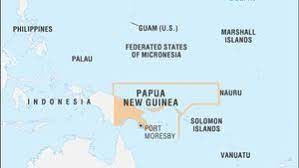
Why in News?
Two frontline Indian naval warships recently made a port call at Port Moresby as part of ongoing initiatives for enhancing maritime partnership and cooperation with Papua New Guinea.
About Papua New Guinea:
- Location: It is an island country that lies in the southwestern Pacific.
- It includes the eastern half of New Guinea(the world’s second-largest island) and many small offshore islands.
- Neighbours: Indonesia to the west, Australia to the south and Solomon Islands to the southeast.
- Capital: Port Moresby
- Terrain: It is mainly mountainous but has low-lying plains in southern New Guinea.
- The islands that constitute Papua New Guinea were settled over a period of 40,000 years by a mixture of peoples who are generally referred to as Melanesians.
- Language:
- English is the main language of governmentand commerce.
- In most everyday contexts, the most widely spoken language is Tok Pisin.
- Linguistically, it is the world's most diverse country, with more than 800 languages.
- Religion: The majority of Papua New Guinea’s people are at least nominally Christian.
- Government:
- Papua New Guinea became self-governing on 1 December 1973 and achieved independence on 16 September 1975.
- The country is a constitutional monarchy and a member of the Commonwealth.
- The British monarch, represented by a governor-general, is the head of state, and the Prime Minister is the head of government.
Source: The Hindu
Mahanadi River
Subject: Geography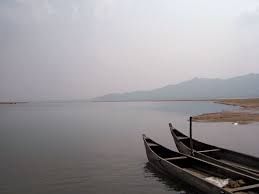
Why in News?
The Odisha government recently alerted the districts in the Mahanadi delta area as it apprehends a “medium” flood in the river system following heavy rains for three consecutive days in the state.
About Mahanadi River:
- It is one of the major east-flowing peninsular rivers in India.
- Origin: The river originates from the Sihawa range of hills in the Dhamtari district of Chhattisgarh state.
- Length: It flows a total of 860 km by distance before it ends up in the Bay of Bengal.
- Course:
- It flows in a southeastern direction through Chhattisgarh and Odisha.
- The catchment area of the basin extends over major parts of Chhattisgarh and Odisha and comparatively smaller portions of Jharkhand, Maharashtra and Madhya Pradesh.
- It passes through several major cities and towns, including Raipur, Sambalpur, and Cuttack.
- The river is bounded in the north by Central India hills, in the south and east by the Eastern Ghats and in the west by Maikal hill range.
- Tributaries: The main tributaries of Mahanadi are Seonath River, Jonk River, Hasdeo River, Mand River, Ib River, Ong River and Telen River.
- Hirakud Dam:
- The Hirakud Dam, the world's longest earthen dam (26km), is constructed across the Mahanadi River, about 15 km from Sambalpur in Odisha.
- The dam is used for irrigation, flood control, and power generation.
- Chilika Lake: Chilika, named wetland of international importance under the Ramsar Convention, gets 61% of its inland flow from the Mahanadi river system, mainly from its distributaries - Daya and Bhargabi.
- It ranks second to the Godavari River among the peninsular rivers in respect of water potential.
GS-II
Parliamentary Privilege and the Privileges Committee: A Closer Look
Subject: Polity
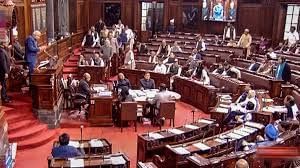
Why in News?
During the ongoing Monsoon Session of Parliament, there were differences between the ruling and opposition parties, leading to complaints against 2 MPs.
- These complaints were referred to the Privileges Committee.
What is Parliamentary Privilege?
- Definition: Parliamentary privilege refers to the rights and immunities enjoyed by legislators during the course of their legislative duties.
- Protection: MPs/MLAs are protected from civil or criminal liability for actions or statements made while discharging their legislative functions.
- Constitutional Basis: The powers, privileges, and immunities of both Houses of the Indian Parliament and their members are enshrined in Article 105 whereas Article 194 deals with State Legislatures.
Understanding Privilege Motion
- Breaching Privilege: Any disregard of the rights and immunities constitutes a breach of privilege and is punishable under parliamentary law.
- Motion: A notice in the form of a motion can be moved by any member of either House against those held guilty of a breach of privilege.
- Contempt Actions: The Houses also have the right to punish actions that may not be a specific breach of privilege but are offenses against their authority and dignity.
Instances of Privilege Notices
- Indira Gandhi’s Expulsion (1978): Indira Gandhi was expelled from the Lok Sabha for obstructing government officials from collecting information for a question on Maruti.
- Subramanian Swamy’s Expulsion (1976): Subramanian Swamy faced expulsion from the Rajya Sabha for engaging in interviews perceived as “anti-India propaganda.”
- Cash for Query Scandal (2005): Eleven “tainted” MPs involved in the cash for query scandal were expelled from the Lok Sabha.
Rules Governing Privilege
- Lok Sabha: Rule No. 222 in Chapter 20 of the Lok Sabha Rule Book governs privilege.
- Rajya Sabha: Correspondingly, Rule 187 in Chapter 16 of the Rajya Sabha rulebook deals with privilege.
- Scope of Notice: The notice must relate to a recent incident requiring the intervention of the House.
- Timing: Notices must be given before 10 am to the Speaker or the Chairperson.
Role of the Speaker/Rajya Sabha Chair
- Scrutiny: The Speaker/RS Chairperson is the first level of scrutiny for a privilege motion.
- Decision Making: They can decide on the privilege motion themselves or refer it to the Privileges Committee.
- Opportunity to Speak: If consent is given under Rule 222, the member involved is given an opportunity to make a brief statement.
Referring to the Privileges Committee
- Composition: In the Lok Sabha, the Speaker nominates a 15-member Committee of Privileges based on respective party strengths.
- Report Presentation: The Committee presents a report to the House for consideration. A half-hour debate may be permitted while considering the report.
- Final Orders: The Speaker may pass final orders or direct that the report be tabled before the House.
- Resolution: A resolution relating to the breach of privilege must be unanimously passed.
- Rajya Sabha: In the Rajya Sabha, the Deputy Chairperson heads the 10-member Committee of Privileges.
Source: The Hindu
Sub-Categorisation of OBCs
Subject: Polity
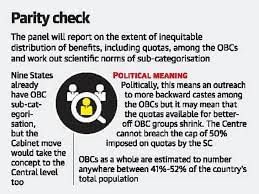
Why in News?
The Justice G. Rohini-headed Commission for the sub-categorisation of Other Backward Classes (OBC) caste groups submitted its long-awaited report to the Ministry of Social Justice and Empowerment after nearly six years of work.
- The details of the recommendations have not been made public yet, and the government is expected to deliberate on the report before any implementation.
What are the Terms of Reference of the Rohini Commission?
- About:
- The commission was set up on 2nd October, 2017 under Article 340 of the Constitution (President’s power to appoint a Commission to investigate the conditions of the backward classes).
- Terms of Reference:
- Examine the inequitable distribution of benefits among OBCs listed in the Central List.
- Propose a scientific approach and parameters for sub-categorisation within OBCs.
- Identify and classify the respective castes or communities into their respective sub-categories.
- Study the entries in the Central List of OBCs and recommend corrections for repetitions, ambiguities, inconsistencies, and errors in spelling or transcription.
What is the Need for Sub-categorisation of OBCs?
- OBCs get 27% reservation in central government jobs and educational institutions, but it is perceived that only a few dominant caste groups among them benefit from this quota.
- In 2018, the commission analyzed the data of 1.3 lakh central government jobs and OBC admissions to central higher education institutions over the preceding years, revealing that 97% of benefits went to 25% of OBC castes.
- Around 983 OBC communities (37% of the total) had zero representation in jobs and educational institutions, highlighting the need for sub-categorisation.
- Sub-categorisation aims to create quotas within the 27% reservation to provide more opportunities for historically underrepresented and crowded-out OBC communities.
What is the Historical Evolution of the OBC Reservation Status in India?
- The journey began with the establishment of the Kalelkar Commission in 1953, which marked the first instance of recognizing backward classes beyond the Scheduled Castes (SCs) and Scheduled Tribes (STs) on a national level.
- In 1980, the Mandal Commission Report estimated that the OBC population constituted 52% and identified 1,257 communities as backward.
- To address the inequity, it suggested an increase in the existing quotas (which were previously applicable only to SC/ST) from 22.5% to 49.5%, extending the reservation to include OBCs.
- Following these recommendations, the central government implemented the reservation policy, reserving 27% of seats in union civil posts and services for OBCs under Article 16(4).
- This policy was also enforced in central government educational institutions under Article 15(4).
- In 2008, the Supreme Court intervened and directed the central government to exclude the "creamy layer" (advanced sections) among the OBCs from benefiting from the reservation policy, ensuring that it reaches the most disadvantaged.
- In 2018, 102nd Constitution Amendment Act granted constitutional status to the National Commission for Backward Classes (NCBC).
- This elevated the NCBC from its previous status as a statutory body under the Ministry of Social Justice and Empowerment, giving it more authority and recognition in safeguarding the interests of backward classes, including the OBCs.
Source: The Hindu
Appointment of Election Commissioner
Subject: Polity
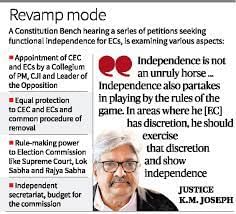
Why in News?
The Supreme Court dismissed a petition filed by the Association for Democratic Reforms (ADR) challenging the appointment of an Election Commissioner.
- The court cited a previous Constitution Bench ruling that had already addressed the issue and decided not to quash the appointment.
About Election Commission of India (ECI)
- The ECI is a constitutional body was established by the Constitution of India to conduct and regulate elections in the country.
- Article 324 of the Constitution provides that the power of superintendence, direction, and control of elections.
- The body administers elections to the Lok Sabha, Rajya Sabha, State Legislative Assemblies, State Legislative Councils and the offices of the President and Vice President of the country.
- Thus, the Election Commission is an all-India body in the sense that it is common to both the Central government and the state governments.
- The Election Commission operates under the authority of Constitution per Article 324 and subsequently enacted Representation of the People Act 1951.
Composition of ECI
- The ECI was established in 1950 and originally only had one Chief Election Commissioner.
- Two additional Commissioners were appointed to the commission for the first time during the 1989 General Election, but they had a very short tenure, ending on 1 January 1990.
- The Election Commissioners are assisted by Deputy Election Commissioners, who are generally IAS officers.
- They are further assisted by Directors General, Principal Secretaries, and Secretaries and Under Secretaries.
- At the state level, Election Commission is assisted by the Chief Electoral Officer of the State, who is an IAS officer of Principal Secretary rank.
- At the district and constituency levels, the District Magistrates (in their capacity as District Election Officers), Electoral Registration Officers and Returning Officers perform election work.
Tenure
- The tenure of election commissioners is not prescribed by Indian Constitution.
- However, the Election Commission conduct of service Act, 1991 prescribes the term of service.
- Chief Election Commissioner or an Election Commissioner shall hold office for a term of six years, or up to the age of 65 years, whichever is earlier, from the date on which he/she assumes his/her office.
Removal from office
- The Chief Election Commissioner of India can be represented removed from their office in a manner similar to the removal of a judge of the Supreme Court of India.
- It requires a resolution passed by the Parliament of India a two-thirds majority in both the Lok Sabha and the Rajya Sabha on the grounds of proved misbehaviour or incapacity.
- Other Election Commissioners can be removed by the President of India on the recommendation of the Chief Election Commissioner.
- A Chief Election Commissioner has never been impeached in India.
Recent incidence of criticisms of ECI
- Over the last couple of years, several actions and omissions of the commission have come in for criticism.
- Nearly 66 former bureaucrats in a letter addressed to the President, expressed their concern over the working of the Election Commission.
- They felt was suffering from a credibility crisis, citing various violations of the model code of conduct during the 2019 Lok Sabha Elections.
Importance of ECI for India
- Conduction of Election: The ECI has been successfully conducting national as well as state elections since 1952.
- Electoral participation: In recent years, however, the Commission has started to play a more active role to ensure greater participation of people.
- Discipline of political parties: It had gone to the extent of disciplining the political parties with a threat of derecognizing if the parties failed in maintaining inner-party democracy.
- Upholds federalism: It upholds the values enshrined in the Constitution viz, equality,
equity, impartiality, independence; and rule of law in superintendence, direction, and control over electoral governance. - Free and fair elections: It conducts elections with the highest standard of credibility, freeness, fairness, transparency, integrity, accountability, autonomy and professionalism.
Issues with ECI
- Flaws in the composition: The Constitution doesn’t prescribe qualifications for members of the EC. They are not debarred from future appointments after retiring or resigning.
- No security of tenure: Election commissioners aren’t constitutionally protected with security of tenure.
- Partisan role: The EC has come under the scanner like never before, with increasing incidents of breach of the Model Code of Conduct in the 2019 general elections.
- Political favor: The opposition alleged that the ECI was favoring the ruling party by giving clean chit to the model code of conduct violations made by the PM.
- Non-competence: Increased violence and electoral malpractices under influence of money have resulted in political criminalization, which ECI is unable to arrest.
Source: Indian Express
GS-III
Ujwal DISCOM Assurance Yojana (UDAY) Scheme: Objectives and Challenges
Subject: Economy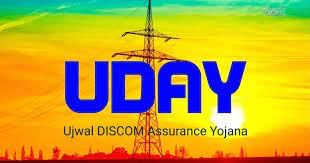
Why in News?
The Comptroller and Auditor General of India (CAG) recently presented its Compliance Audit report (for the year ended March 2021) to assess the implementation of the Ujwal DISCOM Assurance Yojana (UDAY) scheme.
- According to the CAG, the main objective of the financial and operational turnaround of the Maharashtra State Electricity Distribution Company (MSEDCL) was not achieved in spite of implementing the UDAY scheme.
What is the UDAY Scheme?
- In 2015, the Government of India (Ministry of Power) launched UDAY Scheme to aid operational and financial turnaround of Power Distribution Companies (DISCOMs) owned by any state.
- UDAY is basically a debt restructuring plan for DISCOMs (to improve their operational efficiency) and was kept optional for states.
- Joining states to undertake 75% debts of their respective DISCOMs, while the remaining 25% debts will be issued to DISCOMs in the form of bonds.
- These states will receive additional priority funding under numerous schemes such as Deen Dayal Upadhyaya Gram Jyoti Yojana (DDUGJY) and Integrated Power Development Scheme (IPDS).
- This scheme was established with a vision to provide affordable and accessible 24×7 power to all.
- It also aims to provide a solution for revenue-side efficiency and cost-side efficiency and envisages reform measures in the following sectors - generation, transmission, distribution, coal and energy efficiency.
- Initially, the scheme was targeted for four years until 2019, providing a revival package for electricity distribution companies.
- However, after understanding the impact and prospect of this scheme, the government launched ‘UDAY 2.0’ under the Union Budget 2020-21.
Need for UDAY Scheme:
- In India, DISCOMs have been accumulating losses and are under outstanding debt, as these utilities are supplying electricity at tariffs that are far below cost.
- These financially-stressed DISCOMs are not able to supply adequate power at affordable rates, hampering the quality of life and overall economic growth and development.
- Inefficiencies in power distribution, such as large transmission and distribution losses on power, have further strained finances of DISCOMs, who have been heavily borrowing from banks to operate themselves.
- Owing to DISCOMs massive pile of debts and accumulated losses [~Rs. 2.75 lakh crore from 2011-12 to 2014-15], the government decided to develop a financial scheme to aid these DISCOMs and reduce their transmission losses.
Key Objectives of the UDAY Scheme:
- Reduce the aggregate technical & commercial (AT&C) loss (from ~22% to 15%) by 2018-19.
- Improve operational efficiency via ensuring compulsory smart metering, upgrading transformers and meters.
- Adopt energy efficiency measures such as initiate promotion of energy-efficient LED bulbs, etc.
- Reduce power costs, interest burden and power losses in the distribution sector.
- Encourage states to actively participate in the scheme by providing incentives to the performing state.
- In addition, the following advantages will be provided:
- Increased supply of domestic coal
- Rationalization of coal prices
- Faster completion of interstate transmission lines
- Power purchase through transparent competitive bidding, etc.
Achievements of UDAY Scheme:
- Large number of states joined the scheme. This led to the improvements in the liquidity situation of DISCOMs and in the power supply situation.
- The participating states have achieved an improvement in AT&C or distribution losses.
Challenges Faced by the UDAY Scheme:
- AT&C losses are still high: For example, some states have losses of over 40% and only 7 states (TN, Kerala, Gujarat, etc.) have recorded losses of less than 15%.
- Rising share of renewable energy (RE): As the rising share of RE is displacing the low-cost coal in the distribution system, it raises the average cost of supply.
- Bonds are not very profitable: For example, for every 1 lakh crore of UDAY bonds issued results in a loss of up to 6,000 crores for banks and financial institutions that have lent money to them.
- Putting the onus on the states to deal with the situation: This has further strained the State finances.
News Summary:
- MSEDCL could not achieve its targets of bringing down the AT&C losses to the desired level.
- On the contrary, AT&C losses of MSEDCL increased from 16. 94% in 2018-19 to 20.73% in 2020-21.
- This is due to poor collection mainly from agricultural consumers and various State Government departments.
- Thus, the main objectives of achieving financial and operational turnaround of MahaVitaran were not achieved in spite of implementing the UDAY scheme.
- The Government of Maharashtra may ensure that all electricity dues of MahaVitaran from departments and local bodies are cleared in a time bound manner.
- MahaVitaran should complete DT (Direct Connected) metering and feeder segregation expeditiously and reduce the AT&C losses to 15% by improving its billing and collection efficiency.
Source: PIB
Forest Cover in India: Progress and Initiatives
Subject: Environment and Ecology
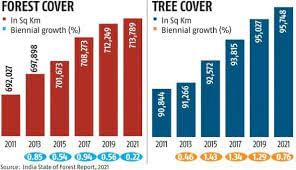
Why in News?
Recently, the Union Ministry of Environment, Forest and Climate Change provided valuable insights into the various initiatives to boost forest cover in India during a written reply in the Lok Sabha.
What are the Major Forest Conservation Initiatives in India?
- About Forest Cover in India:
- The Forest Survey of India (FSI), Dehradun has been conducting biennial (once every two years) assessments of forest cover since 1987, and the findings are published in the India State of Forest Report (ISFR).
- As per the latest assessment in ISFR 2021, India's total forest and tree cover stands at 8,09,537 square kilometers, which accounts for 24.62% of the country's geographical area.
- Notably, this represents an increase of 2261 square kilometers compared to the ISFR 2019 assessment, indicating positive strides in forest conservation efforts.
- Government Initiatives to Boost Forest Cover:
- Green India Mission (GIM): Started in the Financial Year 2015-16, GIM focuses on afforestation activities.
- Over the last five years, Rs. 755.28 Crores has been released to seventeen States and one union territory to support afforestation efforts.
- National Afforestation Programme: Implemented for regeneration of degraded forests and adjoining areas.
- The National Afforestation Programme is now merged with Green India Mission.
- Nagar Van Yojana (NVY): Launched in 2020, NVY aims to create 600 Nagar Vans and 400 Nagar Vatika in urban and peri-urban areas by 2024-25.
- The initiative intends to enhance the green cover, preserve biological diversity, and improve the quality of life for urban dwellers.
- Compensatory Afforestation Fund (CAMPA): Utilized by States/UTs for compensatory afforestation to offset forest land diversion for developmental projects.
- 90% of the CAF money is to be given to the states while 10% is to be retained by the Centre..
- Multi-Departmental Efforts: Apart from the central initiatives, afforestation activities are taken up under various programs and schemes of line Ministries, State Governments/UT Administrations, Non-Government Organizations, Civil Society, and Corporate bodies.
- Some notable efforts include participation in the Mahatma Gandhi National Rural Employment Guarantee Scheme, National Bamboo Mission, and Sub-Mission on Agroforestry.
- Draft National Forest Policy: The policy focuses on integrating climate change mitigation and adaptation measures into forest management practices. It emphasizes building resilience to climate change, particularly among forest-dependent communities.
Source: World Economic Forum
Restrictions on Laptop Imports & Its Implications
Subject: Economics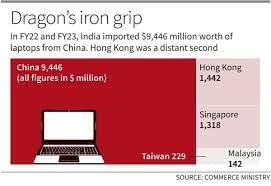
Why in News?
The Union Government’s decision to restrict import of laptops has now been suspended till 1st November, 2023.
What was the Decision Taken by the Union Government?
- On 3rd August, the Union Government imposed restrictions on import of laptops, tablets, all-in-one personal computers and ultra-small computers and servers with immediate effect.
- Any entity or company planning to bring laptops and computers for sale in India will now have to seek permission or license from the government for their inbound shipments.
- The notification in this regard was issued by the Directorate General of Foreign Trade (DGFT).
- The DGFT is the agency of the Ministry of Commerce and Industry, responsible for administering laws regarding foreign trade.
- The restrictions have been imposed under HSN Code 8471 on seven categories of electronic gadgets.
- The Harmonized System of Nomenclature (HSN) code is a classification system used to identify products for taxation purposes.
- HSN Code 8471 is used to identify devices that are designed to perform data processing tasks.
- This decision has now been suspended till 1st November, 2023.
- The DGFT had to suspend the implementation as custom officials stationed at ports started holding up shipments of the specified electronic items.
Why did the DGFT Impose Ban on Import of Laptops & Similar Electronic Goods?
- Although the DGFT notice did not specify any reason behind the change in policy, the move is largely being seen as a push for the Centre’s ‘Aatmanirbhar Bharat’mission and a bid to reduce dependencies on China.
- Aatmanirbhar Bharat Abhiyan is the mission started by the Government of India in May 2020, towards making India Self-reliant.
- China Factor –
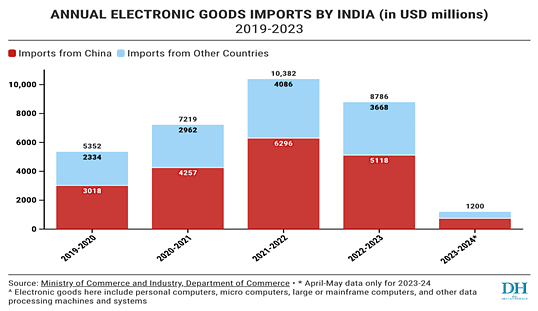
- Given this fact, a rise in indigenous manufacturing would not only help India reduce its dependence on its diplomatic and business rival but would also help indigenous manufacturers expand their footprint globally.
- Security Factor –
- The restrictions may have been brought in to guard against electronic hardware coming in with “in-built security loopholes that may potentially endanger sensitive personal and enterprise data”.
- Across the world, many red flags have been raised about cybersecurity with regard to Chinese-manufactured electronics.
- An importer of such goods will have to apply for a license once the ban comes into effect.
- The trader should have to be a regular importer to get a license.
- Licenses can be taken for one year and companies can apply multiple times.
- Exemptions have also been given on import of one laptop, tablet, all-in-one personal computer or ultra-small form factor computer, including those purchased from e-commerce portals through post or courier.
- Also, there is an exemption from seeking import licensing for up to 20 items per consignment for R&D, testing, benchmarking and evaluation, repair and return, and product development purposes.
- Shortly after the announcement, shares of local electronics contract manufacturers have gone up.
- Further, the government's announcement is expected to impact companies that import bulk of their products from outside India.
- Big Corporations like Apple will have to either start manufacturing their laptops in India or stop importing their gadgets to India.
- The same rule will also apply to other PC manufacturers like Lenovo, HP, Asus, Acer, Samsung.
- This will likely lead to an increase in the price of current laptops, computers, MacBooks, and Mac Minis in the Indian market.
- The restriction is likely to impact the sales and discounts that retailers and companies offer from time to time.
- If the demand will go up, the retailers will have no incentive to offer any discounts on the laptops.
- Government of India has identified electronics manufacturing as a key priority area for the country’s future growth ambitions and is hoping to attract investments from global electronic corporations.
- Under Production-Linked Incentive 2.0 IT hardware scheme, 44 companies have already been registered and two companies have filed their application on the scheme portal by July 31, 2023.
- However, this import ban on laptops and similar electronic items could open the door for imposition of similar licensing requirements in other sectors, increasing the space for bureaucratic discretion.
- This decision might also lead to unnecessary disruption in the immediate term, create supply shortages and raise prices of electronic equipment.
Source: The Hindu
|
63 videos|5408 docs|1146 tests
|





















